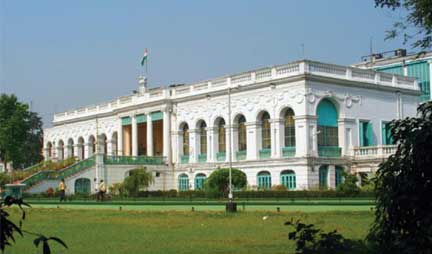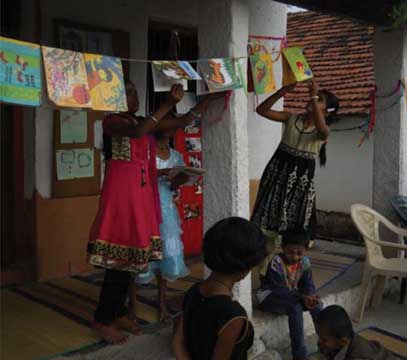Usha Mukunda
‘I have always imagined that Paradise will be a kind of library.’ – Jorge Luis Borges
The library as a symbol and a place of knowledge and memory
Over the ages, the library has always held pride of place. Not only does it have the unique quality of a place that houses precious and rare memories and materials, but the outer shell too seems to convey this sense of grandeur.
The Egyptians and the Sumerians stored their clay tablets, papyrus, and cuneiform in sacred places like temples. The famed library at Alexandria had been built as an imposing structure to keep all the writings gathered from all over the world. Already there was thought given to safety and preservation. Unfortunately, except for the discovery of clay tablets at Nineveh from Ashurbanipal, most of these places as well as their contents were unable to withstand the ravages of time and are long gone.
Libraries were available to the Greeks and Romans too. But where were they? Many Greeks had libraries in their homes but these were private places. The Romans placed libraries for easy access in their baths and gymnasiums. One cannot help having an image of a reader exercising, enjoying a bath and ending up with a leisurely read! These interesting places for libraries did not last either. Over the years that followed, Byzantine and Benedictine monks, and Islamic mullahs, each in their own ways played a major role in copying out documents in exquisite calligraphic forms. These were placed in mosques and monasteries some of which have survived and found a home in museums and libraries. Care was given to produce beautiful documents. It was not enough to have the knowledge preserved but the aesthetic beauty of the documents became of paramount importance. At the same time, attention was given to the outward appearance and image of the place.

The emergence of national libraries and public libraries around the world led to large and magnificent structures as places to gather and preserve knowledge.
As students in Calcutta, I remember the sense of awe we all shared as we entered the imposing building of the National Library. All over the world, there are innumerable such examples of magnificent and beautifully designed libraries. Some of them like the Bodleian Library at Oxford continue to be exclusive and permit only serious scholars and researchers into their sanctorum! But the public library movement ensured free access and opened their doors and windows to ALL! These are places not only of collective memory but also encourage active use of their holdings through open access, displays and interactions. They send out a strong message that while they are the keepers of precious and rare material, they are also social places of gathering where open dialogues and discourses happen. The British Library at London is a place where the visitor can gaze at old documents like the Magna Carta or read the original letter written by Michelangelo to his nephew in 1550, giving gentle advice on how to select a wife! The Public Library at Vancouver, Canada is an example of a place that provides for social interactions, talks, debates as well as informal sharing of books. An encounter there with Michael Yahgulanaas, the First Nations author of The Flight of the Hummingbird was one of the highlights of my visit to that library.
An interesting point to note is that libraries were places where a knowledgeable group of individuals had gathered precious materials. They were the owners and carers of the place and its collection, and had the power to decide who could have access. Many libraries now recognize the vital presence of the readers and look to engage with them more directly, thus opening the door for shared ownership as well as shared responsibility. Happily this blurs the line drawn between providers and users!
Over time and across cultures, the library as a place seems to have been inherent. The place was chosen as a sacred place, a place to gather wisdom and knowledge, a safe place, and gradually as a more open and public-friendly place.
Library as a place in time
A book I stumbled across recently, What time is this place? by Kevin Lynch, triggered reflections on this aspect of the library. It is a place in time and as such is subject to change, recurrence, and alas even destruction. There are so many libraries across time that have experienced looting, burning and natural disasters as well. Even though the place may have gone, the soul of the library remains, and regenerates into another place. It is the spirit of the library that has stood the test of time and is able to locate itself afresh into another place.
One obvious way in which the library is a place in time is its preservation of historical material, local as well as global. But it is also flexible and consonant with present reality. Janus-like, the library as a place in time looks both backward and forward.
A place as a library
We have looked at library as a place. How does a place become a library?
This is where a vision for the library transforms a place into a vibrant living entity. A library vision emerges from observation, reflection and has breadth and depth. The human resource in the library is the touchstone for a vision that is enduring and yet responsive to change when and where necessary, a vision that encompasses present needs and future possibilities and a vision that flows seamlessly into daily practice. It can be the shared vision of a group of people who are in dialogue with each other. Or it may be born in one mind and embraced by others. It is a vision that is revisited often to ensure freshness and relevance. Then the place becomes a library in all the ways described here.
• An inclusive place where a person can feel welcomed and at ease. There are no rigid rules except for ones of mutual convenience and sensitivity.
• A place where all the senses come alive. A place where every reader or visitor can look, browse, inhale, touch, and listen to the muted creak of a chair, a sigh from a reader, a stifled sneeze and the scratch of a pen!
• A place of infinite possibilities and dreams. A place where imagination runs wild and brings about new ideas and new dreams!

In a children’s library the location or the placing of the library is very crucial. It must be central to the children’s consciousness and easy to access. In one of the schools I visited, the library was on the third floor, laid back among other large buildings, and unless the students were asked to go there by some teacher, there was no movement and flow of children through the day to take in the excellent displays that the librarians had devised. It just took too long to get there, and during breaks, the tuck shop and games field were closer and far more inviting!
Once the library is strategically placed, the next important aspect is that of free access. In a school library, children, teachers, management, parents and grandparents, other librarians, and visitors in general are welcomed. To cater to all needs, the collection has variety, diversity and reaches out to a broad range of interests. It has displays to arouse curiosity and lead to further browsing. It supports learning for students, teachers and others. It enhances reading through innovative activities and enables a space for free dialogue. All this is done without compromising the basic function of a school library – to support, enrich and enhance the curriculum.
A community library is a place of gathering for the inhabitants of that community. Young and old can find something here to keep them engaged, interested and wanting to come again. The collection here includes stories, craft items, art work, traditional board games, and healthy and healing recipes from members of the community. Here too there is a need for activities and interactions that further the bond between book and reader, between reader and reader, and between reader and library educator.
The vital question of value in the library as a place
At the simplest level one can call the library a place that connects people and books. This is not a passive relationship but one of reciprocity. The library can change people and people can change the library!

As a place, the library encompasses both the outer and the inner. While a grand and imposing exterior has its impact, the place has no integrity without the inner. The value of the place and the values it conveys in myriad and intangible ways is the core of the library. A vibrant collection, active interaction over books and resources, and above all, freedom and autonomy for the users makes it a valued library. If the inner has vigour and vibrancy and emerges from minds that have love and care, the place is a library in the fullest sense, even if the trappings are simple.
Over the ages, the library as a place has embodied the value of knowledge, reflection and lifelong learning. As library educators in present times, we can convey these vital aspects not only through our collection but also in our commitment to the values of inclusion, freedom, trust and openness by demonstrating this in the library as a place. Such a library will always have a ‘place’ in our hearts and minds.
References
- Weise, F. (2004) Being there: The Library as place. Journal of the Medical Library Association: JMLA, 92(1), 6-13.
- Manguel, Alberto. (1997) A history of reading. New York. Penguin Books.
- Kevin Lynch. (1972) What time is this place? Cambridge Massachusetts. MIT Press.
The author has happily interacted with books and children for over 35 years now. As a school and children’s librarian, she has learnt much from these interactions and is always looking and listening to refresh her ideas about reading, books and libraries. She is deeply interested in exploring and sharing the nuances of good literature for children. She is also passionate about nurturing a discernment regarding books in readers wherever they may abide. She can be reached at usha.mukunda@gmail.com.
